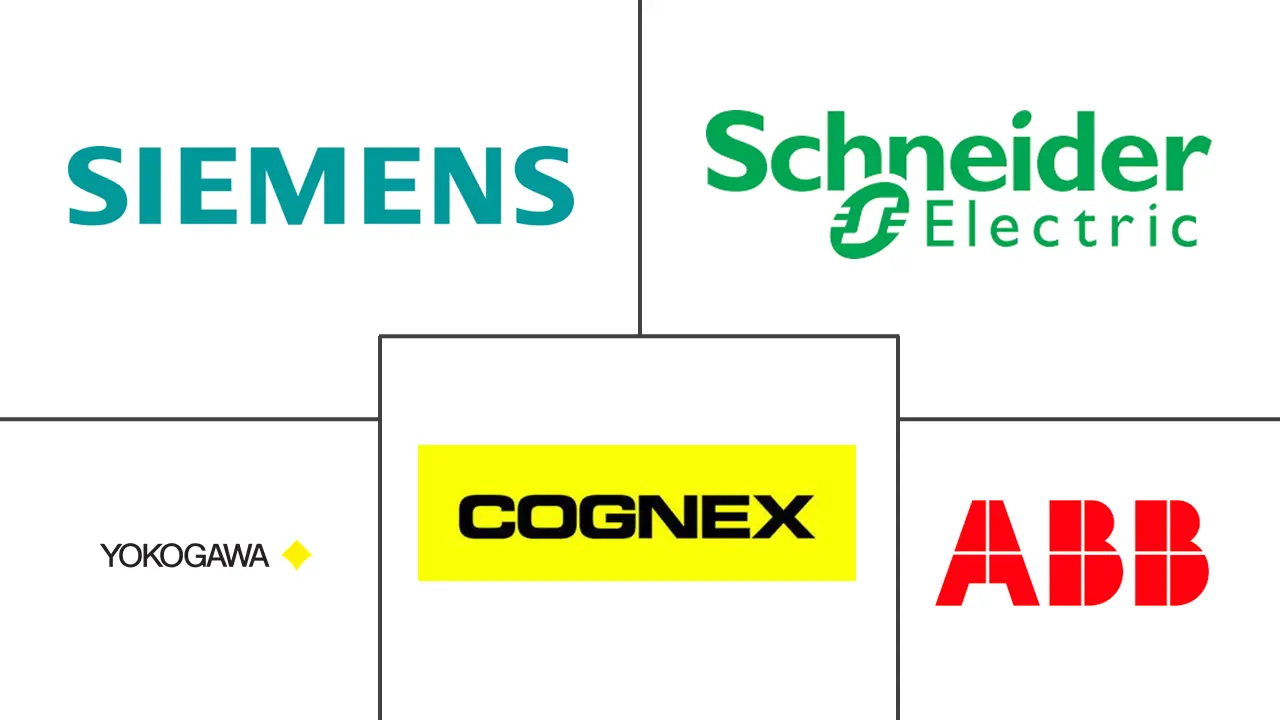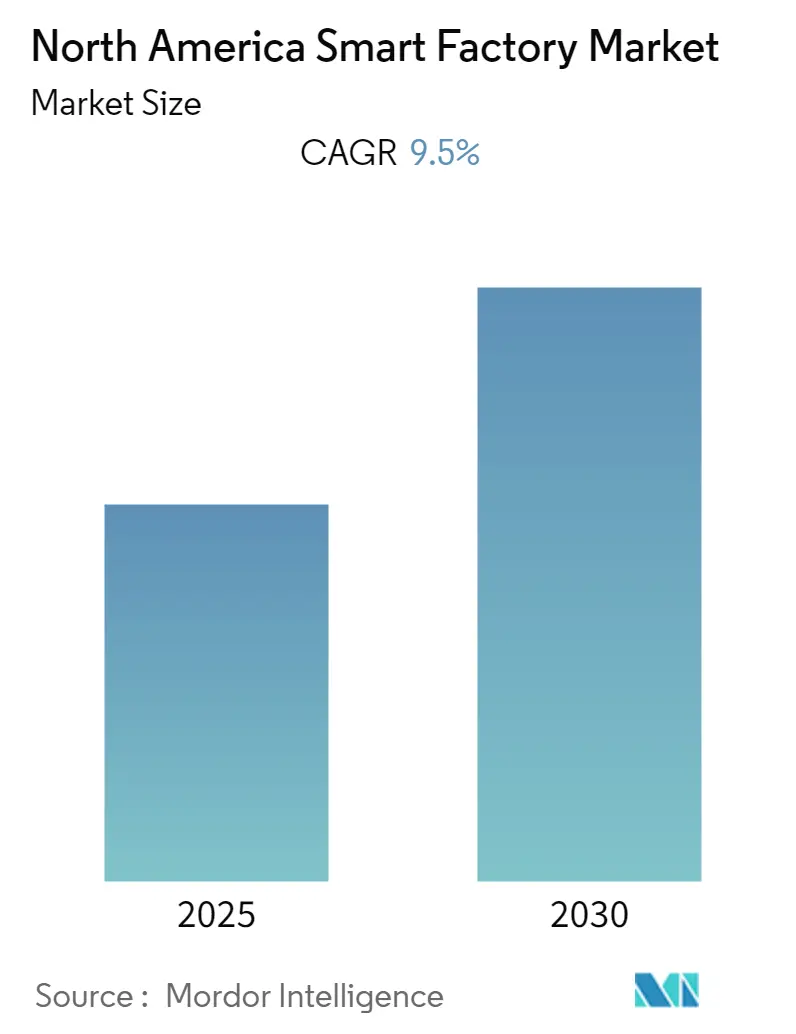
North America Smart Factory Market Analysis by Mordor Intelligence
The North America Smart Factory Market is expected to register a CAGR of 9.5% during the forecast period.
- The Maryville University estimates that by 2025, over 180 trillion gigabytes of data will be created worldwide every year. A large portion of this will be generated by IIoT-enabled industries. A survey by the Industrial IoT (IIoT) giant, Microsoft, found that 85% of companies have at least one IIoT use case project. This number will increase, as 94% of the respondents said they will implement IIoT strategies by 2021.
- IoT technologies are overcoming the labor shortage in the manufacturing sector, especially in the developed countries, like the United States. Due to this, the Federal Government and the private sector in the United States are investing in Industry 4.0 IoT technologies, to increase the American industrial base, which was taken over by China and other low labor cost countries. Therefore, IoT technologies may mainly drive the adoption of smart factory solutions, across the world.
- Also, the recent increase in tariffs is likely to force manufacturers of the United States to produce goods at a lower cost, which is to be achieved through automation. Auto companies that invested in automation pre-tariffs are ahead of the game, and they are the cost-saving blueprint for other companies. Companies that produce industrial robots and automation products are set to benefit, as they are the largest producers of the robots and equipment needed for automation.
- Automation technologies, such as collaborative robots, require human intervention/ interaction. Furthermore, industrial control systems (ICS) are laced with security risks. Hence, ICS security solutions must be installed to prevent security threats to the systems, which increases the cost of maintaining ICS. Nevertheless, advancements in cybersecurity solutions are reducing the fear of security issues associated with ICS.
North America Smart Factory Market Trends and Insights
Semiconductor Industry is Observing a Significant Growth
- The electronics industry in the region is growing at a steady pace and holds a prominent share in a number of enterprises operating in the design and fabless space. According to the US Census Bureau, the revenue of the semiconductors and other electronic components sector is expected to reach USD 105.16 billion by 2023.
- Moreover, the region commands significant demand for smartphones and consumer electronics, which is driving demand for the studied market. According to Ericsson, smartphone subscription is expected to reach 360 million by 2025, augmented by the demand from 5G.
- Additionally, the increasing demand for smart wearables in the region is spearheading the demand for semiconductors in the region. By 2022, the number of connected wearable devices in North America is expected to reach USD 439 million, according to Cisco Systems. Such developments are augmenting demand for the market in the region.
- According to the Semiconductor Industry Association (SIA), the semiconductor industry directly employs nearly a quarter of a million workers in the United States. The United States is also home to some of the world's major automotive players, who are investing in electric vehicles and in the self-driving potential of cars, which demand high-performance ICs. This is one of the major factors to drive demand for the semiconductors silicon wafers market. For instance, in December 2020, Group14 Technologies, a global provider of silicon-carbon composite materials for lithium-ion applications, secured USD 17 million in Series B funding led by SK Materials.
- The pandemic has been brutally bad for many people and industries in the United States, but the semiconductor industry has been one of the only bright spots. That translates to additional demand for chips of all sorts, which increased the pressure on a supply chain that was already running as fast as it could. Thus, driving market players to invest in product development.
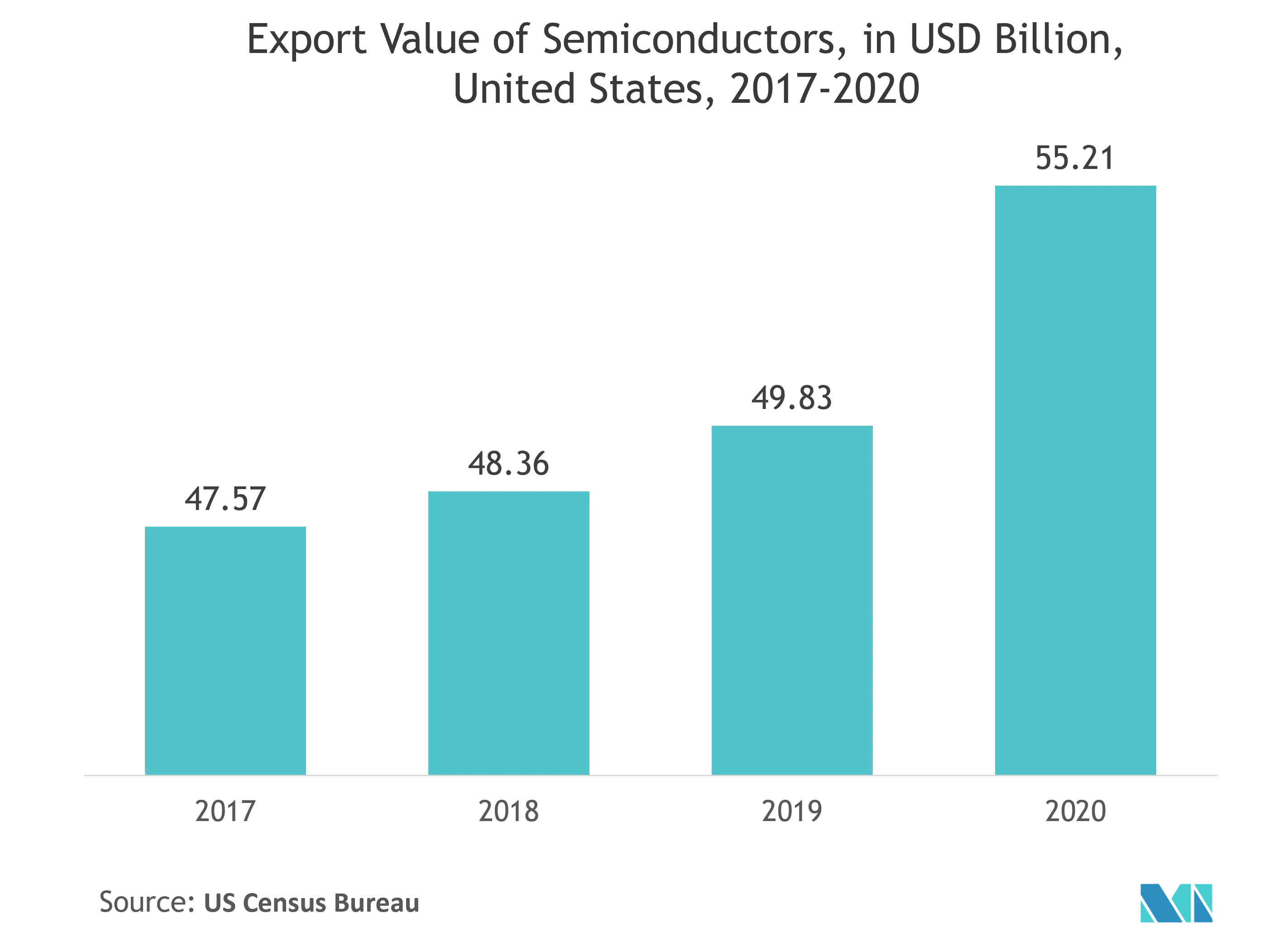
Communication is One of the Segment Driving the Market
- Wired communication tends to have a relatively low degree of distortion when delivering information from a particular source to a destination. For instance, receiving digitally encoded data from a wired analog to digital converter, sent to a single digital controller at a fixed rate of 8 kbit/second, occurs with little data loss and distortion, i.e., only the least significant bits tend to have errors. In addition, there are wired networking protocols that aim to achieve a relatively constant delay profile by using a token to control access to the network, such as PROFIBUS-DP and ControlNet.
- For instance, FieldComm Group, PI (Profibus & Profinet International), and ODAVA are working together to promote developments for Industrial Ethernet. It is aimed to expand the use of EtherNet/IP, HART-IP, and PROFINET into hazardous locations in the process industry, leveraging the work currently underway in the IEEE 802.3.cg.
- Wireless networks are advancing in ways that are driving many possibilities for industrial automation. The idea of wireless industrial automation has long been an unachievable goal for many organizations, but 5G is starting to make this goal a reality. Companies are already beginning to deploy private 5G networks within plants and are seeing an increase in performance, low latency, determinism, and reliability.
- For instance, Corning and Verizon have installed a 5G Ultra-Wideband service in Corning’s fiber optic cable manufacturing facility in Hickory, United States. Corning will use Verizon’s 5G technology to test the application of 5G to enhance functions, such as factory automation and quality assurance, in one of the most extensive fiber optic cable manufacturing facilities in the world.
- Individual devices incorporating wireless communication are generally costlier than wired networks. However, this increased upfront cost offset in multiple ways. Wireless devices often prove to be the most cost-effective option over the long run, owing to factors such as saving the cost of running cabling through a production area.
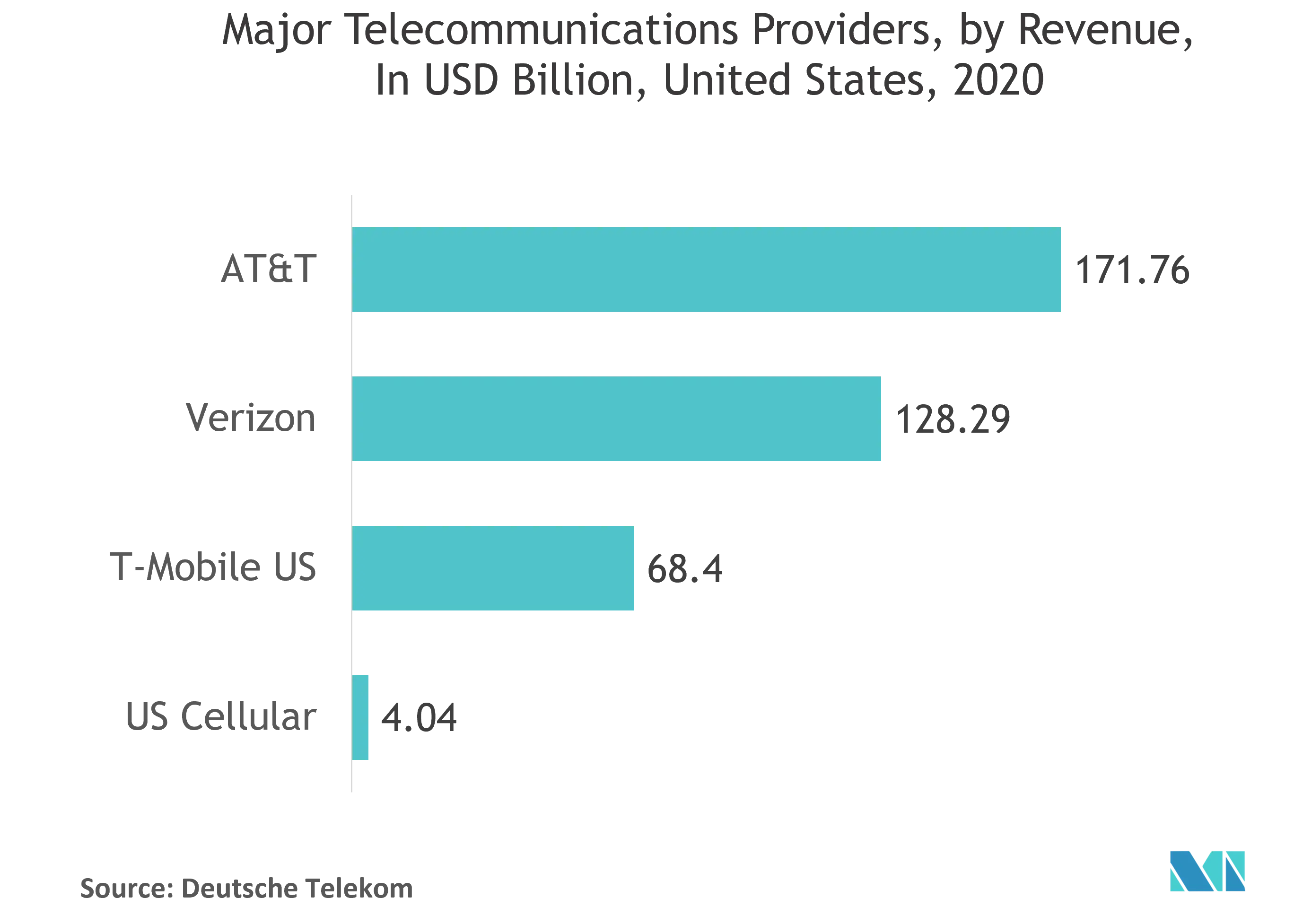
Competitive Landscape
The North American Smart Factory Market is moderately consolidated, with the presence of a few major companies. The companies are continuously investing in making strategic partnerships and product developments to gain more market share. Some of the recent developments in the market are:
- April 2021- Mitsubishi Electric Corporation developed seven new X-Series products, including two HVIGBTs and five HVDIODEs, bringing the total number of X-Series power semiconductor modules to 24. These modules are designed for increasingly big-capacity, small-sized inverters used in traction motors, DC-power transmitters, substantial industrial machines, and other high-voltage, large-current equipment. Beginning in July, the models will be released in order.
- September 2020 - Siemens and Grundfos signed a digital partnership framework for strategic cooperation between the two companies to focus on complementary products and solutions provided by both parties in three main areas: water and wastewater applications, industrial automation and building technology.
North America Smart Factory Industry Leaders
ABB Ltd
Cognex Corporation
Siemens AG
Schneider Electric SE
Yokogawa Electric Corporation
- *Disclaimer: Major Players sorted in no particular order
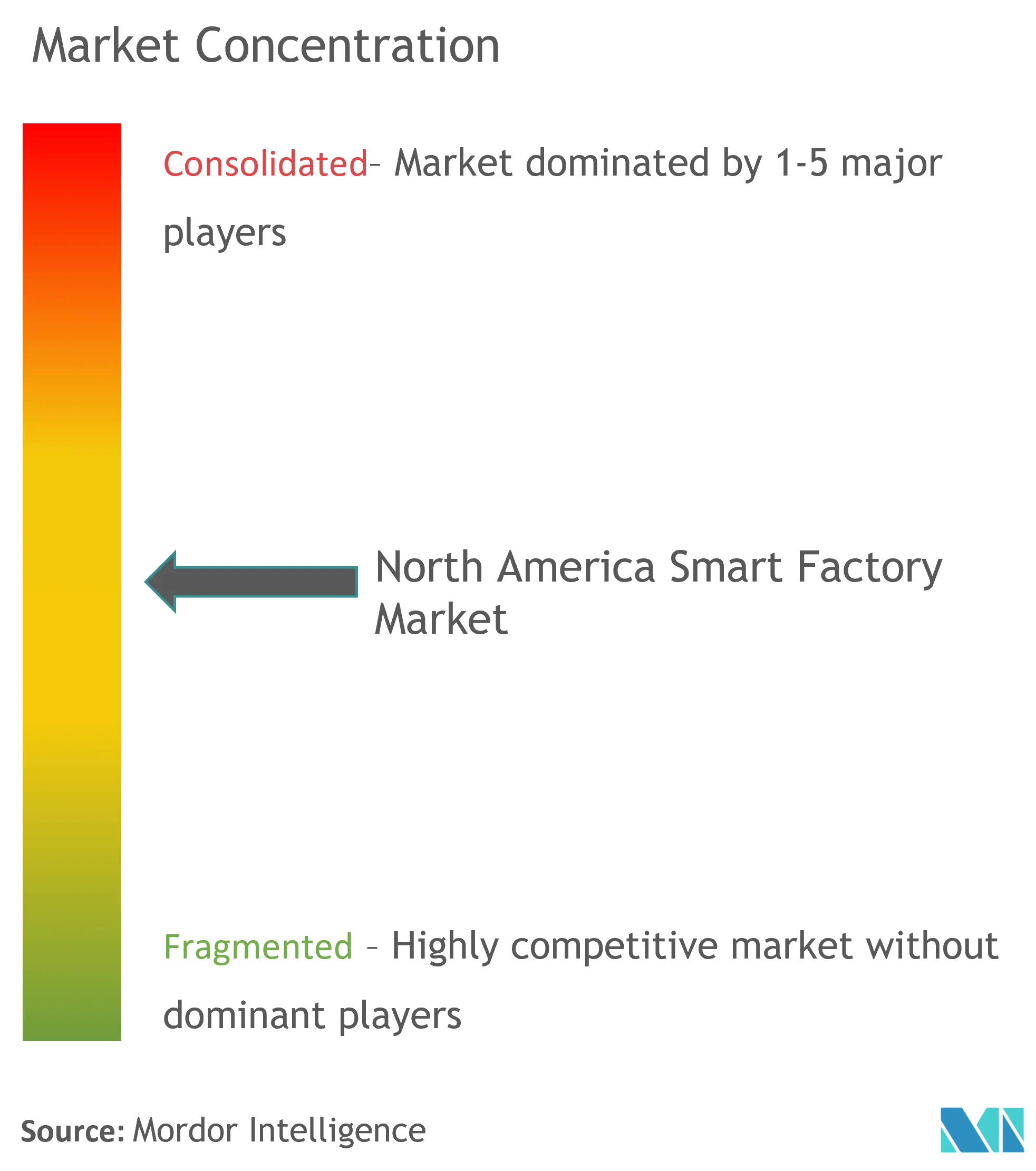
North America Smart Factory Market Report Scope
The North American Smart Factory Market is segmented by product type, namely machine vision systems, and industrial robotics, among others, and by technology, which includes SCADA, PLC, and HMI, among others. The factories or manufacturing facilities in the North American region adopting smart technologies to enhance their operations are mainly considered under the scope of this study.
| Machine Vision Systems | Cameras |
| Processors | |
| Software | |
| Enclosures | |
| Frame Grabbers | |
| Integration Services | |
| Lighting | |
| Industrial Robotics | Articulated Robots |
| Cartesian Robots | |
| Cylindrical Robots | |
| SCARA Robots | |
| Parallel Robots | |
| Collaborative Industry Robots | |
| Control Devices | Relays and Switches |
| Servo Motors and Drives | |
| Sensors | |
| Communication Technologies | Wired |
| Wireless | |
| Other Products |
| Product Lifecycle Management (PLM) |
| Human Machine Interface (HMI) |
| Enterprise Resource and Planning (ERP) |
| Manufacturing Execution System (MES) |
| Distributed Control System (DCS) |
| Supervisory Controller and Data Acquisition (SCADA |
| Programmable Logic Controller (PLC) |
| Other Technologies |
| Automotive |
| Semiconductors |
| Oil and Gas |
| Chemical and Petrochemical |
| Pharmaceutical |
| Aerospace and Defense |
| Food and Beverage |
| Mining |
| Other End-user Industries |
| United States |
| Canada |
| By Product | Machine Vision Systems | Cameras |
| Processors | ||
| Software | ||
| Enclosures | ||
| Frame Grabbers | ||
| Integration Services | ||
| Lighting | ||
| Industrial Robotics | Articulated Robots | |
| Cartesian Robots | ||
| Cylindrical Robots | ||
| SCARA Robots | ||
| Parallel Robots | ||
| Collaborative Industry Robots | ||
| Control Devices | Relays and Switches | |
| Servo Motors and Drives | ||
| Sensors | ||
| Communication Technologies | Wired | |
| Wireless | ||
| Other Products | ||
| By Technology | Product Lifecycle Management (PLM) | |
| Human Machine Interface (HMI) | ||
| Enterprise Resource and Planning (ERP) | ||
| Manufacturing Execution System (MES) | ||
| Distributed Control System (DCS) | ||
| Supervisory Controller and Data Acquisition (SCADA | ||
| Programmable Logic Controller (PLC) | ||
| Other Technologies | ||
| By End-user Industry | Automotive | |
| Semiconductors | ||
| Oil and Gas | ||
| Chemical and Petrochemical | ||
| Pharmaceutical | ||
| Aerospace and Defense | ||
| Food and Beverage | ||
| Mining | ||
| Other End-user Industries | ||
| By Country | United States | |
| Canada | ||
Key Questions Answered in the Report
What is the current North America Smart Factory Market size?
The North America Smart Factory Market is projected to register a CAGR of 9.5% during the forecast period (2025-2030)
Who are the key players in North America Smart Factory Market?
ABB Ltd, Cognex Corporation, Siemens AG, Schneider Electric SE and Yokogawa Electric Corporation are the major companies operating in the North America Smart Factory Market.
What years does this North America Smart Factory Market cover?
The report covers the North America Smart Factory Market historical market size for years: 2019, 2020, 2021, 2022, 2023 and 2024. The report also forecasts the North America Smart Factory Market size for years: 2025, 2026, 2027, 2028, 2029 and 2030.
Page last updated on:
North America Smart Factory Market Report
Statistics for the 2025 North America Smart Factory market share, size and revenue growth rate, created by Mordor Intelligence™ Industry Reports. North America Smart Factory analysis includes a market forecast outlook for 2025 to 2030 and historical overview. Get a sample of this industry analysis as a free report PDF download.
